
Halifax Citadel National Historic Site is in the middle of Nova Scotia's capital/Tourism Nova Scotia/Acorn Art & Photography
Tastings And Tours At The Halifax Citadel
By Darcy Rhyno
On a paper placemat filled with tasting notes, three special Glencairn nosing glasses stand in a line. Each is placed on the name of the spirit it contains: Noon Gun Gin, Fort George Genever and Daily Ration Rum. A bonus glass of Granite & Grain Whisky stands behind them. All are made by Compass, a new Halifax distillery on Agricola Street, a short walk from here.
I’m at the Halifax Citadel National Historic Site, participating in a couple of tours themed for spirits, one of the distilled variety, the other of the supernatural. Each of the drinks before me on the “Raise Your Spirits” tour is named in honor of this star-shaped fortress atop the 22.6-hectare (55-acre) Citadel Hill that overlooks the heart of Nova Scotia’s capital.
“Feel free to try the first one, Noon Gun Gin,” says Sergeant Andrew Crawley, our host and tasting guide. “It’s named after the noon gun, but also a ‘gun gin,’ which is a sort of hoist to put artillery pieces on gun carriages, so it’s a play on words.”
Playing the part of a 78th Highlander from the period 1869-71, Crawley is handsomely dressed in his red doublet, a kilt with a sporran, and white spats over red-and-white checkered stockings. He says the regiment was popular with Haligonians because they brought colour and pageantry to the city.
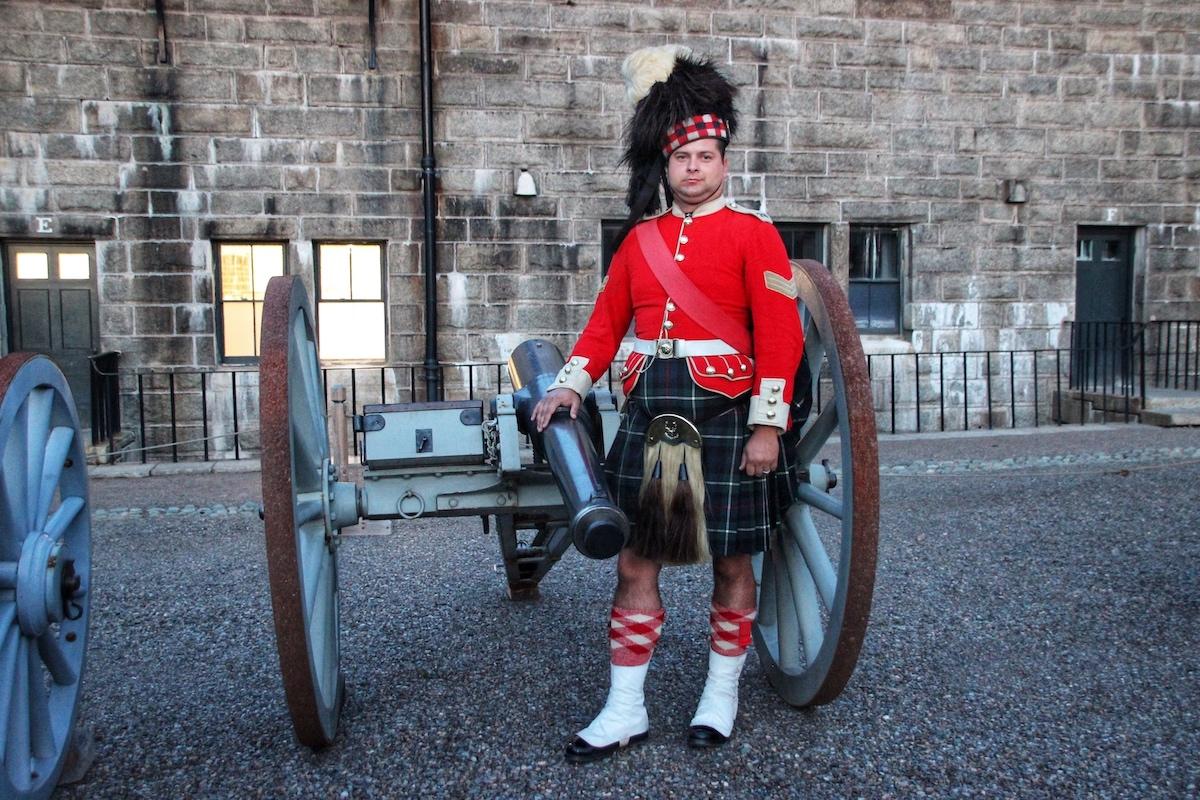
Sgt. Andrew Crawley serves as host and tasting guide at the Halifax Citadel/Darcy Rhyno
Every day when the clock strikes noon, a 12-pounder gun is fired from the Citadel on the summit, a tradition that dates to 1865. The boom reverberates across the city. Haligonians have come to expect the blast, but visitors are often startled. They’re better off witnessing the 10-minute process of loading and firing the noon gun on a visit to the Citadel.
“Spirits are served at room temperature,” Crawley says, walking us through the steps of a tasting. “For each, pick up the glass, take a look at its color and clarity. Swirl it around. The traditional nosing glass will help. Hold your glass a few inches from your nose. Take a sniff, then a small sip. Arch your tongue so it flows over all those flavor centres. Notice how the spirit finishes.”
Compass distills Noon Gun Gin from Nova Scotia wheat and 10 traditional botanicals, such as juniper and coriander. The gin and the other Compass spirits are aged right here in the North Magazine at the Citadel. “Adjacent to this building is a room filled with American oak barrels,” Crawley says. “They’re all aged for various lengths of time based on the type of spirit.”
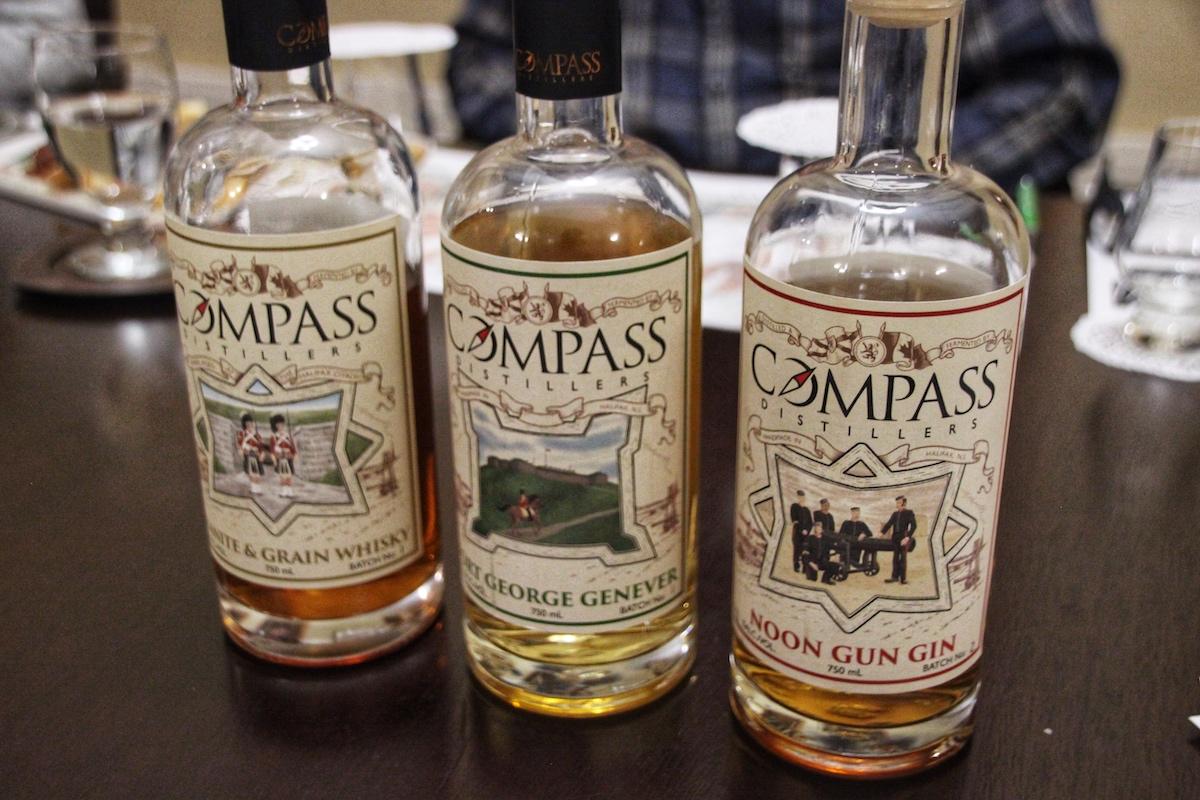
Compass spirits are served on the Halifax Citadel's Raise Your Spirits tour and tasting/Darcy Rhyno
Next up is the Fort George Genever, honoring the fourth and current fortress built atop Citadel Hill. It’s officially known as Fort George, named after King George II. The drink is new to me. As Crawley explains, it’s a Dutch precursor to gin distilled from rye, corn, and malted barley, flavoured with spices like juniper, but also caraway, frankincense, and pink peppercorn, giving it a spicy bite.
Fort George guards the narrows that links the Atlantic Ocean to the expansive Bedford Basin where ships find haven. The Citadel is the centrepiece of a mighty military establishment called the Halifax Defence Complex, a web of strongholds around the mouth of the harbor. At the centre of the narrows, Fort Charlotte on Georges Island (now Georges Island National Historic Site) was the final fortification built and rebuilt there over a 250-year period. The Prince of Wales Tower National Historic Site in Point Pleasant Park and York Redoubt National Historic Site share the southern shores of the harbor with the Citadel. On the opposite shore, the remains of Fort McNab on the less accessible McNabs Island complete the complex as Fort McNab National Historic Site.
As we move on to Daily Ration Rum — made with Crosby molasses from Saint John, New Brunswick — Crawley does a deep dive into the military history of rum, its rationing, and its use as a recruiting tool. “During our time period, there were about 300 licensed and unlicensed groggeries about the city,” Crawley tells us. “Sailors on ships would have grog — half rum, half water. Their daily ration varied over time. Recruiting sergeants standing around rum houses, pubs and groggeries waited for somebody to stumble out to enlist them with the Queen’s shilling.”
Accepting the Queen’s shilling or 13 pennies — the daily wage for a private — was like signing a contract, Crawley says. But some pressed into service tried to outsmart the system. “Serial deserters would take the shilling, desert the next day, then go find another recruiting sergeant and take the Queen’s shilling again.”
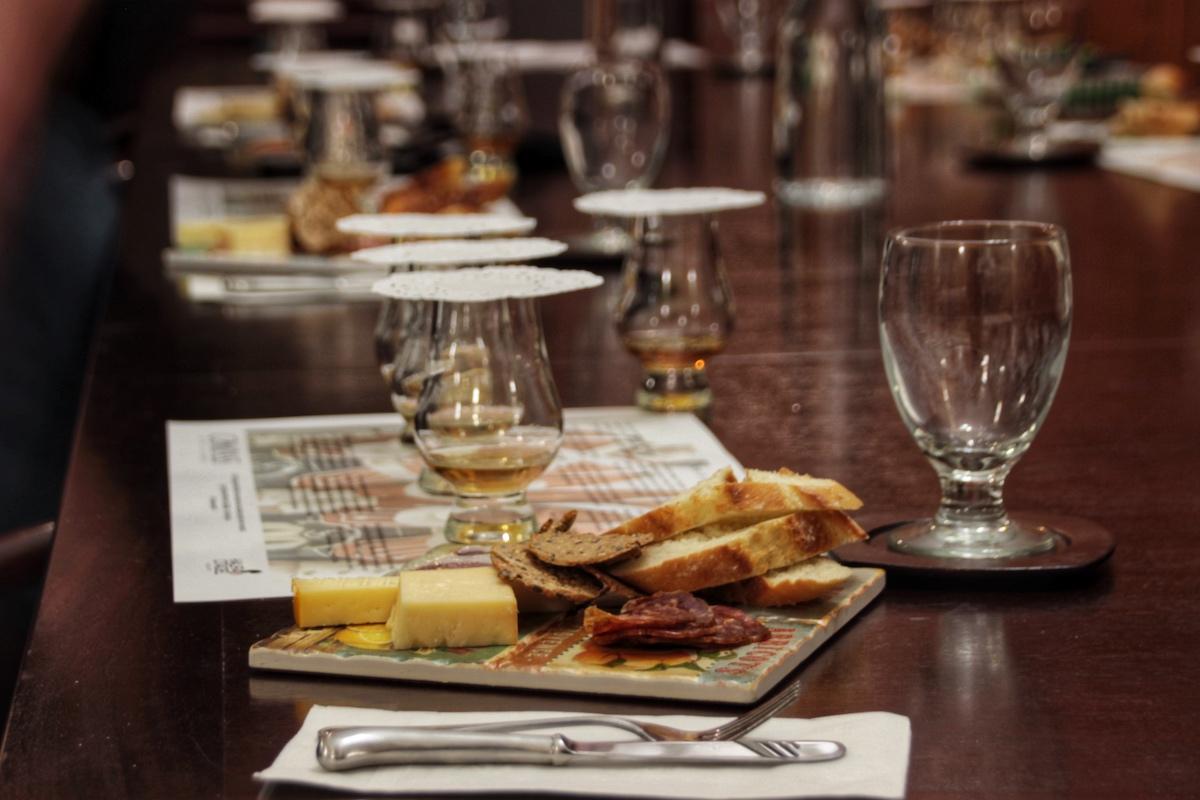
Charcuterie and drink samples on the Raise Your Spirits tour and tasting/Darcy Rhyno
We finish up with the Granite & Grain Whisky named for the Nova Scotia-grown corn and rye that’s milled, mashed, and double distilled into whisky at Compass. It’s then aged four years inside the granite walls of the fortress. Before heading outside, I grab a few last morsels from the generous charcuterie boards of local cheeses, such as world champion Avonlea cheddar from Prince Edward Island, and cured meats like duck prosciutto from Ratinaud, a traditional French food shop on Gottingen Street just down the hill.
The “Raise Your Spirits” tour is one of three tasting tours available to the public from May to October. Groups can book private tastings year-round. The holiday version, “Raise Your Holiday Spirits” featuring Compass Spiced Rhumb, is offered every Friday from late November to mid-December.
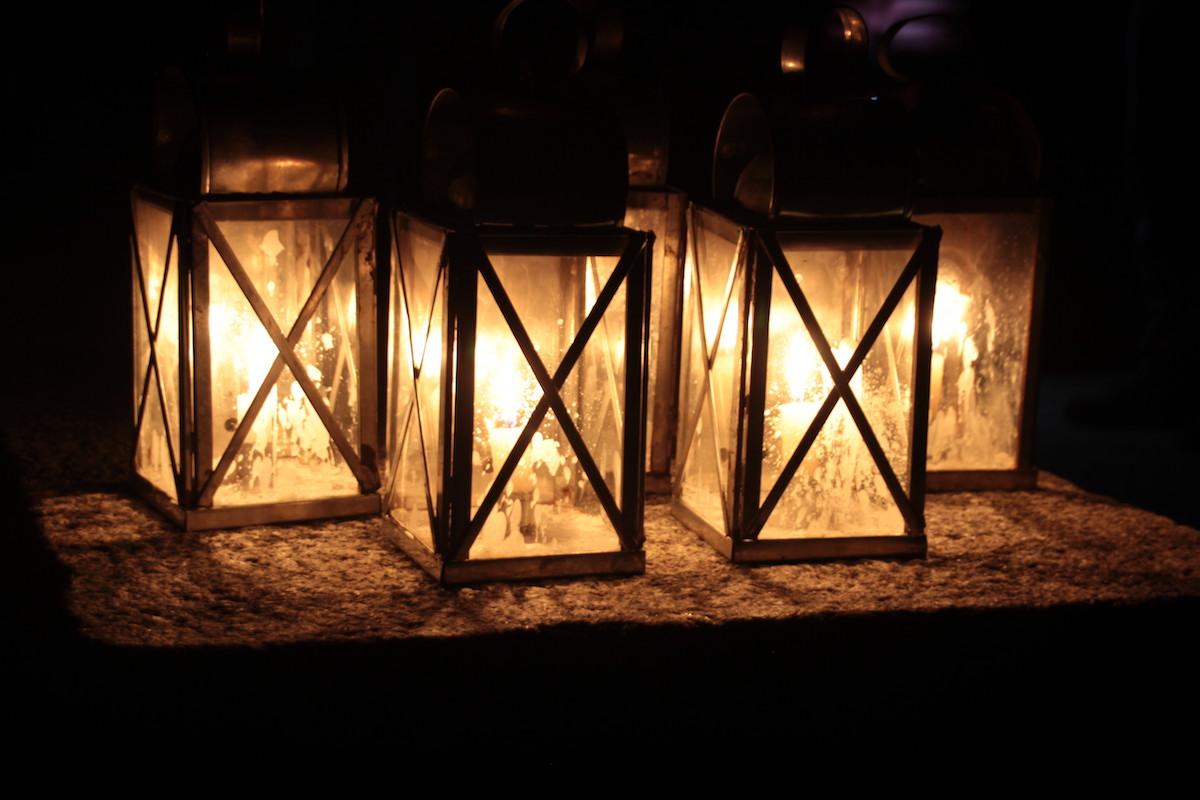
Candle-lit lanterns set the mood on a ghost tour/Darcy Rhyno
By the time we get outside for the second of our spirit-themed experiences, darkness has fallen. We’re led to a shadowy corner of the parade square to meet up with the mysterious Mr. Adams, our guide for the Ghost Tour. He never uses his first name. Light flickers across his face as he hands each of us a candlelight lantern. After his introduction, he leads us across the cobblestones to the centre of the square. The handle of my lantern creaks as I walk.
It’s a misty evening. The fortress’s high ramparts block most of the city lights, so the square is dark. Mr. Adams is dressed in the drab, loose clothing of an off-duty officer with the 78th Highlanders.
“This is our flagship tour, as far as I’m concerned,” Adams tells us, his lantern raised so we can see his face. “For the next 45 minutes, I’ll take you as close as I possibly can to the location where unexplained events took place at the Citadel. Everything you’re going to hear is absolutely true.”
He motions to the darkened three-storey building to the north.
“We’re going to the Cavalier Building and then a powder magazine. By the end of the tour, we’ll be in the dark and underground.”
He points out a sliver of light beneath a door near the main gate where we entered the fortress.
“Since 1749, we’ve always had guards at the Citadel. They sit in the security office right over there and do their rounds with a flashlight to check every single door and window. They’ve seen the same trespasser over and over—The Grey Lady of the Cavalier Building. She’s often spotted right by the door to the Army Museum. I can show you the exact location.”
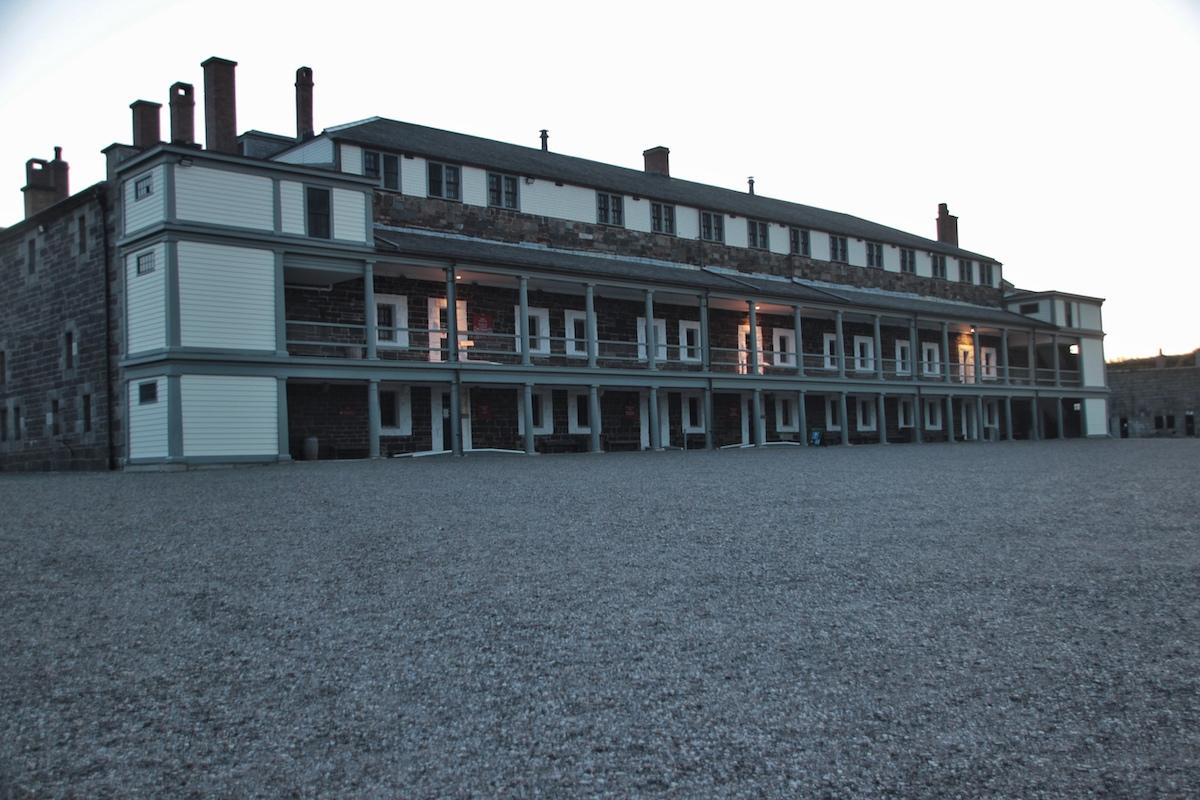
The Cavalier Building at dusk/Darcy Rhyno
Suddenly more than a little spooked, I follow Adams up the stairs to the entrance of the museum. “The Cavalier Building was mostly barracks rooms back in the 1800s. Nowadays, we’ve got an information center, gift shop, coffee shop and some museum exhibits. This is the Army Museum here on the second floor. The third floor is administration offices,” he tells us.
The Army Museum is operated by a non-profit organization. Since 1953, it’s documented Halifax’s role in the first and second world wars with exhibits and some 70,000 artifacts. Both Parks Canada and the Nova Scotia Museum contribute to its operations.
Indicating the door before us, Adams continues. “The Grey Lady most often appears right here. We found dozens of reports that describe a young lady in an old-fashioned white dress. A couple of guards say it’s a light grey, which is where she gets her nickname.”
The ghost is so famous, an oil painting of her is featured on a Canadian postage stamp released in 2015.
Adams spins his tale out through time and back again, linking the apparition to a story he found in a newspaper from November 5, 1901, that recorded an incident in which a bride was left at the altar of a nearby church. Her groom, Sgt.-Major Edwards, committed suicide in the Citadel, possibly because someone discovered that he was already married.
“He was lying right in the barracks doorway,” Adams tells us in hushed tones. “Next to him on the floor was his army issued Carbine, which had recently been fired. The bride walked up the hill, across the parade square to the bottom of that rickety, wooden staircase and right along these boards here. This was her destination because this was Sgt.-Major Edwards' barracks room. We can’t prove that this person is our Grey Lady, but she sure fits the bill.”
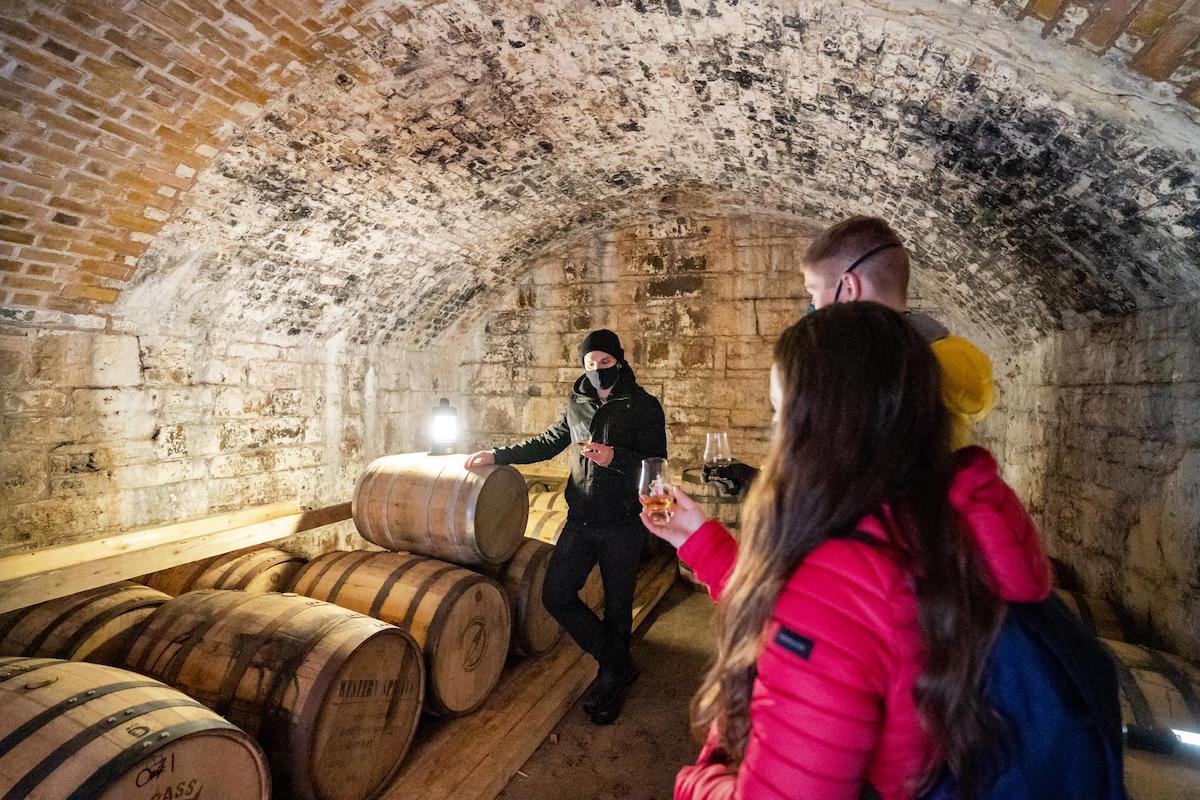
Exploring the Citadel with a guided spirits tour and tasting/Tourism Nova Scotia, Photographer: @daveyandsky
We make our way to the North Magazine for more creepy tales and a little architectural interpretation. This building with its very thick walls and thin ceiling is where massive amounts of explosives were once stored. If there was ever an accident, the hope was that the blast would be directed upwards rather than outwards across the square.
From here, Adams shows us to a small door that leads both into the ditch surrounding the fortress and inside its very walls. We duck along a narrow passageway for a couple of minutes before we come to a dead end. Adams points out a sealed doorway that he says leads to one of 60 tunnels spread out across the hillside beyond the fortress walls.
“Each of these tunnels branches off into two more tunnels,” Adams says. “That’s a total of 180 tunnels. They’re called mine galleries. If we knew the enemy was approaching, we would take 180 soldiers and tell them to take a sandwich and a stethoscope to the bottom of the mine galleries at the end of these tunnels.”
Adams explains the purpose of their mission. “They would sit there with their stethoscopes against the wall for hours or maybe days or weeks. As long as it took. Eventually, one of these soldiers would hear digging. They would clear everybody out of the tunnels and load it full of explosives, run a wire back into the fort and detonate the explosives using an electrical charge. The side of Citadel Hill would erupt, killing anyone who was trying to climb up the side of Citadel Hill. If anyone tried to regroup, we had 180 of those things.”
It’s a relief to make our way back along the passageway to emerge into the open square. We thank Adams for a gripping tour and set our lanterns aside. He guides us to the drawbridge and through the arched, stone gateway to the view of the famous Town Clock. I’m surprised by the comfort I feel at the sight of its gleaming, white walls, and the modern city lights beyond.

Comments
Very enjoyable, entertaining and informative.